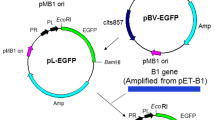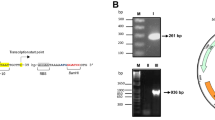Abstract
Genetically engineered Escherichia coli, expressing the fusion protein of enhanced green fluorescent protein (EGFP) and carboxylesterase B1 (CarE B1), was successfully constructed by cloning the genes into the pET-28b vector and then transforming E. coli BL21 (DE3). Expression of the fusion protein was induced in E. coli BL21 (DE3) which could then degrade environmental pesticides and could be easily detected using fluorescence spectrophotometry or by the naked eye in daylight.



Similar content being viewed by others
References
Asperen KV (1962) A study of house fly esterase by means of a sensitive colorimetric method. J Insect Physiol 8:401–416
Barata C, Solayan A, Porte C et al (2004) Role of B-esterases in assessing toxicity of organophosphorus (Chlorpyrifos, Malathion) and carbamate (Carbofuran) pesticides to Daphnia magna. Aquat Toxicol 66:125–139
Cormack BP, Valdivia R, Falkow S et al (1996) FACS-optimized mutants of the green fluorescent protein (GFP). Gene 173:37l–374
Gory L, Montel MC, Zagorec M (2001) Use of green fluorescent protein to monitor Lactobacillus sakei in fermented meat products. FEMS Microbiol Lett 194:127–133
Lan WS, Cong J, Jiang H et al (2005) Biodegradation of pesticide pollutants by two kinds of enzymes coexpressed in genetically engineered bacteria. Bull Environ Contam Toxicol 75:335–342
Lindow SE (1995) The use of reporter genes in the study of microbial ecology. Mol Ecol 4:555–566
March JC, Rao G, Bentley WE (2003) Biotechnological applications of green fluorescent protein. Appl Microbiol Biotechnol 62:303–315
Mouches C, Pauplin Y, Agarwal M et al (1990) Characterization of amplification core and esterase B1 gene responsible for insecticide resistance in Culex. Proc Natl Acad Sci USA 87:2574–2578
Nishi K, Huang H, Kamita SG et al (2006) Characterization of pyrethroid hydrolysis by the human liver carboxylesterases hCE-1 and hCE-2. Arch Biochem Biophys 445:115–123
Nolte C, Matyash M, Pivneva T et al (2001) GFAP promoter-controlled EGFP-expressing transgenic mice: a tool to visualize astrocytes and astrogliosis in living brain tissue. Glia 33:72–86
Vontas JG, Small GJ, Hemingway J (2000) Comparison of esterase gene amplification, gene expression and esterase activity in insecticide susceptible and resistant strains of the brown planthopper, Nilaparvata lugens (Stål). Insect Mol Biol 9:655–660
Wu CF, Cha HJ, Rao G et al (2000) A green fluorescent protein fusion strategy for monitoring the expression, cellular location, and separation of biologically active organophosphorus hydrolase. Appl Microbiol Biotechnol 54:78–83
Zhang J, Lan W, Qiao C et al (2004a) Bioremediation of organophosphorus pesticides by surface-expressed carboxylesterase from mosquito on Escherichia coli. Biotechnol Prog 20:1567–1571
Zhang JL, Qiao CL, Lan WS (2004b) Detoxification of organophosphorus compounds by recombinant carboxylesterase from an insecticide-resistant mosquito and oxime-induced amplification of enzyme activity. Environ Toxicol 19:154–159
Acknowledgements
This research was supported by the National High Technology Research and Development Program of China (863 Program) (No.2002AA601160, No. 2006AA06Z423) and CAS Innovation Program (KSCX3-IOZ-0701). Authors would like to thank Dr. Shi-Le Huang for reviewing the manuscript and Dr. Susan Nozell for help with the English.
Author information
Authors and Affiliations
Corresponding author
Rights and permissions
About this article
Cite this article
Li, Q., Chen, R., Li, W. et al. A genetically engineered Escherichia coli, expressing the fusion protein of green fluorescent protein and carboxylesterase B1, can be easily detected in the environment following degradation of pesticide residues. Biotechnol Lett 29, 1357–1362 (2007). https://doi.org/10.1007/s10529-007-9410-x
Received:
Revised:
Accepted:
Published:
Issue Date:
DOI: https://doi.org/10.1007/s10529-007-9410-x




